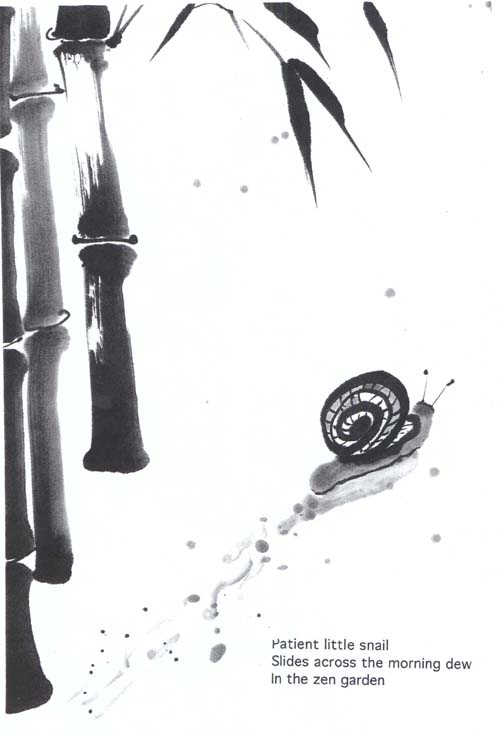Haiku (俳句, haiku)¶ is a mode of Japanese poetry, the late 19th century revision by Masaoka Shiki of the older hokku (発句, hokku), the opening verse of a linked verse form, haikai no renga. The traditional hokku consisted of a pattern of approximately 5, 7, 5 on. The Japanese word on, meaning "sound", corresponds to a mora, a phonetic unit similar but not identical to the syllable of a language such as English. (The words onji, ("sound symbol") or moji (character symbol) are also sometimes used.) A haiku contains a special season word (the kigo) representative of the season in which the renga is set, or a reference to the natural world.
Haiku usually combines three different phrases, with a distinct grammatical break, called kireji, usually placed at the end of either the first five or second seven morae. In Japanese, there are actual kireji words. In English, kireji is often replaced with commas, hyphens, elipses, or implied breaks in the haiku. These elements of the older haiku are considered by many to be essential to haiku as well, although they are not always included by modern writers of Japanese "free-form haiku" and of non-Japanese haiku. Japanese haiku are typically written as a single line, while English language haiku are traditionally separated into three lines.
In Japanese, nouns do not have different singular and plural forms, so 'haiku' is usually used as both a singular and plural noun in English as well.
In Japanese, nouns do not have different singular and plural forms, so 'haiku' is usually used as both a singular and plural noun in English as well.
Senryu is a similar poetry form that emphasizes humor and human foibles instead of seasons, and which may not have kigo or kireji.
Haiku (俳句)¶ (Bài cú) là loại thơ độc đáo của Nhật Bản, xuất phát từ ba câu đầu (発句 hokku, phát cú) của những bài renga (連歌 liên ca) có tính trào phúng gọi là renga no haikai (連歌の俳諧) mà sau gọi tắt là haikai (俳諧 bài hài). Thể thơ haiku được tạo ra vào thế kỉ 17 và phát triển mạnh vào thời kì Edo (1603 - 1867) khi đã dần mất đi sắc thái trào phúng mà mang âm hưởng sâu thẳm của Thiền tông. Thiền sư thi sĩ lỗi lạc Matsuo Basho được thừa nhận là người khai sinh ra haiku và Yosa Buson, Masaoka Shiki đã hoàn thiện nó dưới diện mạo và tên gọi như chúng ta thấy ngày nay. Đây có lẽ là thể thơ ngắn nhất thế giới bởi mỗi bài haiku, mặc dù đôi khi ta vẫn thấy có những hình thức khác, nhưng thường chỉ vỏn vẹn 17 âm tiết trong 3 câu 5+7+5 (17 âm tiết tiếng Nhật có khi chỉ vài ba từ ít ỏi, 3 câu trong cú pháp haiku cũng thường được viết thành một dòng). Chẳng hạn bài thơ con ếch nổi tiếng sau đây của Matsuo Bashō trong tập Xuân nhật (Haru no hi, 1686) viết chung với đồ đệ, có cú pháp 5+7+5 âm tiết:
古池や Furuikeya (Phư-rư-i-kê-ia)
蛙飛び込む Kawazu tobikomu
(Ka-oa-dư-tô-bi-kô-mu)
水の音 Mizu no oto (Mi-dư-nô-ô-tô)
Ao cũ
Con ếch nhảy vào
Vang tiếng nước xao.
Với dân tộc Nhật Bản, haiku được xem như tinh hoa của văn hóa dân tộc. Dưới góc nhìn của Thiền tông, haiku là thể thơ đặc biệt có thể hàm chứa được thực tại nhiệm mầu trong vỏn vẹn 17 âm tiết, vừa sâu lắng uyên thâm, lại vừa đơn sơ giản dị, nhiều khi trở thành phương tiện hữu hiệu truyền tải một công án để các môn sinh tu tập Thiền. Chủ đề của thơ haiku thường lồng vào khung cảnh của bốn mùa.

Không có nhận xét nào:
Đăng nhận xét